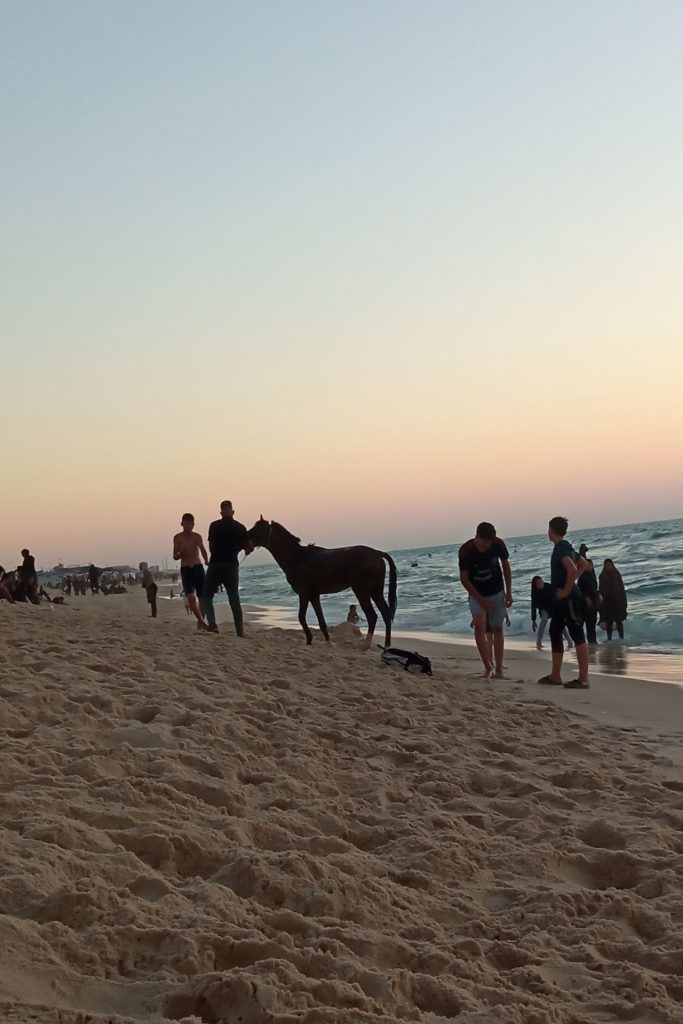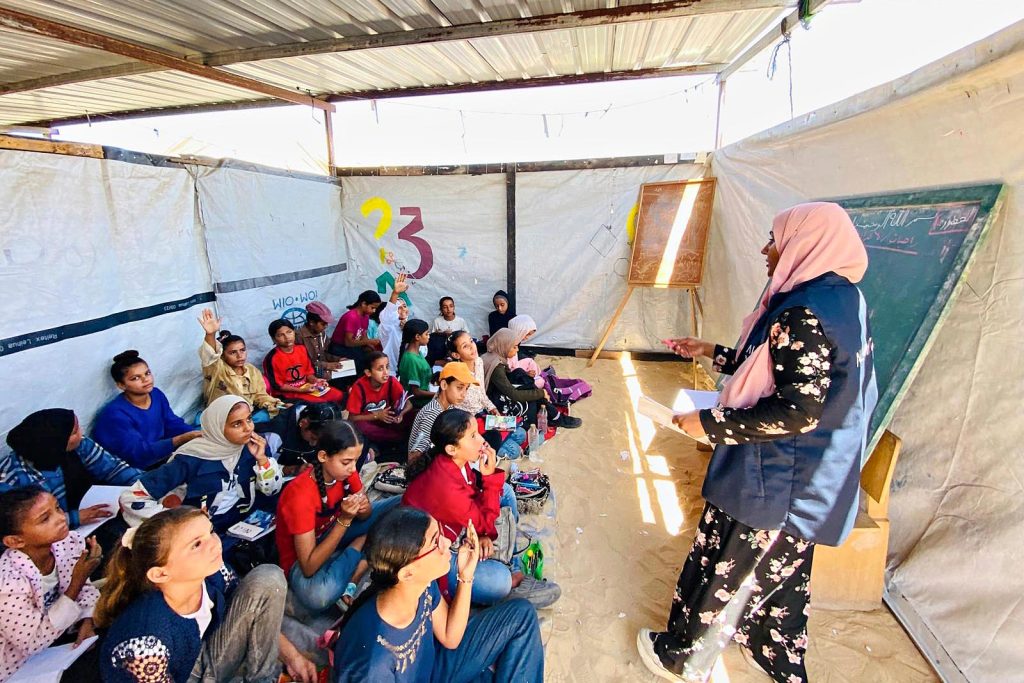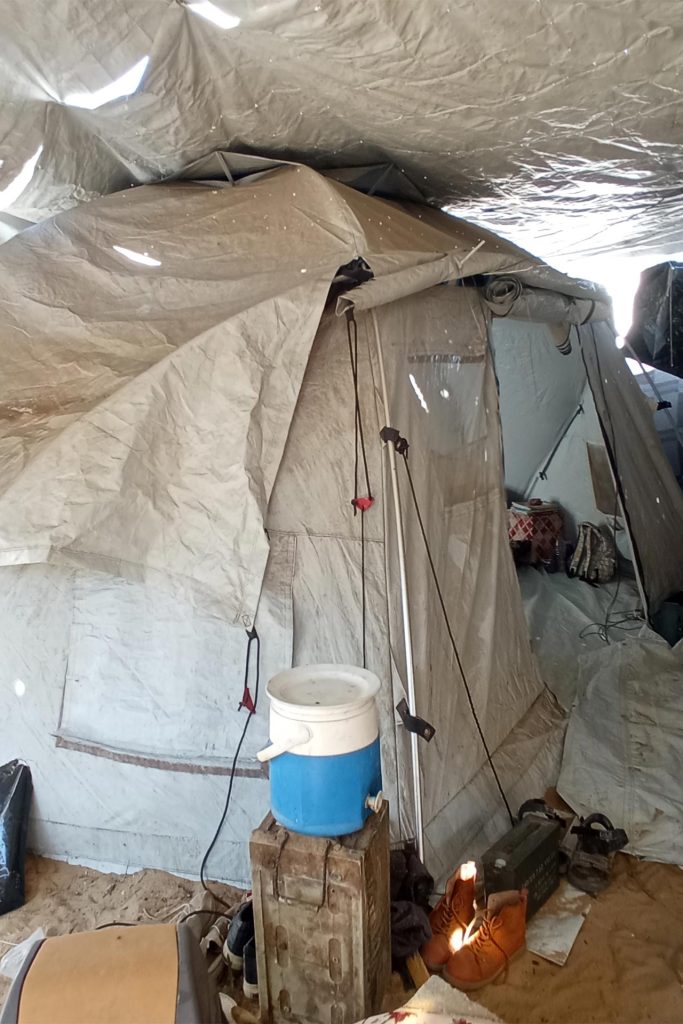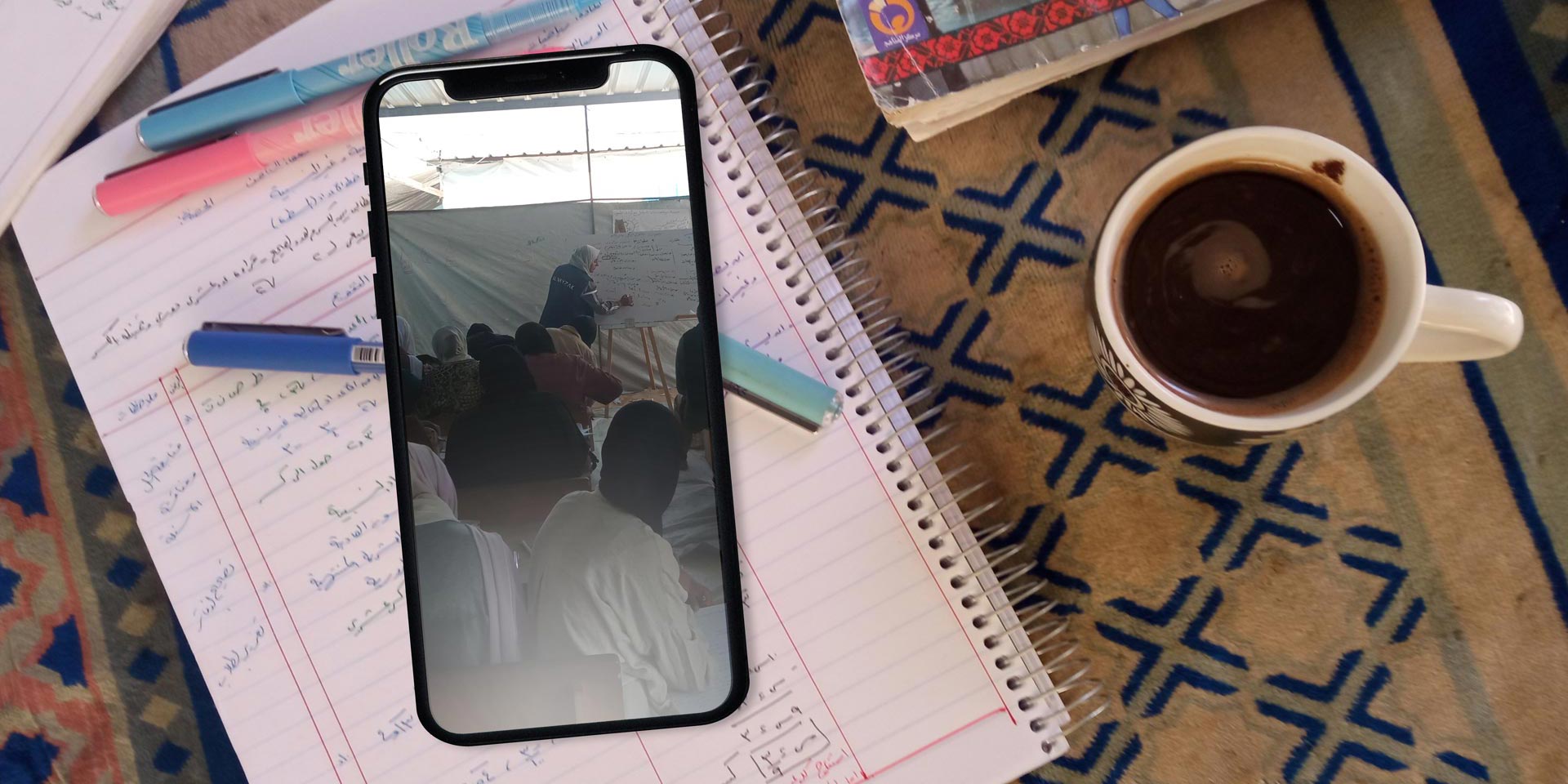Notes from the midst of destruction
Notesfromthemidstofdestruction
A teacher’s extraordinary diary reveals what life is like in Gaza after two years of war
A teacher shared her daily experiences from a refugee camp in Khan Yunis in the southern Gaza Strip. This unique diary, compiled from audio messages, reveals what life is like in the midst of two years of destruction.
Text and diary editing: Ulriikka Myöhänen • Translation: Ramez Bazna
Photos: Haneen Abu Sebla • Visual design: Nici Lönnberg & Ville Nykänen
THE PHONE SCREEN flashes to indicate new messages. Two young women look at the camera in a selfie, with white sand visible in the background. In the following pictures, the evening sun sets over the sea, children bathe in the water, and a horse rises from the waves.
Friday night in a war zone may look like a normal gathering of friends on the Mediterranean coast, but other images flashing up on the phone reveal the harsh reality of primitive tent conditions, frighteningly empty water tanks, and the behaviour of small children who have simply experienced too much horror.

One of the women posing in the selfie is 28-year-old Haneen Abu Sebla, a teacher from Gaza who graduated in 2019. Haneen lost her brother and her home in the war and has since settled with her family in a refugee tent camp in Khan Yunis, in southern Gaza. She teaches mathematics at a temporary tent school supported by Finn Church Aid together with its partner organization al-Nayzak.
TWO YEARS of bombings, attacks, and the almost total obstruction of aid deliveries have pushed the Gaza Strip to the brink of a humanitarian crisis whose scale is difficult to put into words. The homes of the two million inhabitants have been almost completely destroyed, and in some parts of the Strip people have been dying of starvation for months.
In October 2025, news arrives from the Middle East of a ceasefire that is also intended to secure humanitarian aid in the region. The news is small, welcome glimmers of hope, but overnight it cannot erase the suffering of civilians that has accumulated over many years.
In her diary, teacher Haneen describes how she copes in the midst of crisis and the importance of human interaction when a person has lost everything else.

Thursday, September 11, 2025 – 7:11 p.m.
“Good evening from Khan Yunis, where I live in a small tent near the sea. We fled here from Rafah a year and a half ago. I share the tent with my mother, father, grandfather, four brothers, and four sisters. The space is cramped, we suffer from rain and cold in winter, and it is scorching hot in summer. There are constant shortages of electricity and water, and we can only get food occasionally. Sometimes we cannot get basic supplies because the border crossings are closed and there is not enough aid available. We try to adapt to the difficulties as best we can.”
THE WAR IN GAZA has lasted for nearly two years. In September 2025, the city of Gaza is under heavy attack from Israel, and tens of thousands of civilians are fleeing from the north to the south. Many Gazans who have lost their homes are living in tent camps in Khan Yunis. According to the UN, 1.9 million people, or 90 per cent of the inhabitants of the Gaza Strip, have been forced to leave their homes during the war. Some have fled up to ten times.
Friday, September 12, 2025 – 11:54 a.m.

“Good morning and blessed Friday to us and to you. On this holy day, we rise early, clean our home, prepare for prayer, make lunch, and chat with family members. People seek safety in Khan Yunis, but there are also many attacks and explosions here. Bombs and gunfire threaten many areas. In the evening, I walk to my friend’s tent and we go to the beach together, where the local children wash themselves. We also see a horse swimming. I take lots of pictures there.”
IF YOU HAVE NEVER experienced war, you may be surprised to see how something resembling normality can emerge in the midst of completely exceptional circumstances – whether it be a swimming trip for children or a coffee break with a friend. Routines help people cope day by day, even in the midst of war, but they do not eliminate basic human needs. The entire population of Gaza, estimated at two million, is in need of humanitarian aid. There is a shortage of food, water, medicine, and security.
Saturday, September 13, 2025 – 11:49 a.m.
“We started the day with a light breakfast. We ate beans and bread and drank a little tea. In recent months, the situation has been really bad due to famine. We had to get by on one meal a day for three days. The famine was also noticeable at school. The children couldn’t concentrate, they lost weight and their faces were pale. Sometimes we managed to provide a snack. A croissant or other pastry cheered up our students and made them happy. The situation has now eased a little, as some aid trucks have arrived in the area. However, the products on sale are very expensive. The situation is the same for everyone, which makes our plight easier to bear. Sometimes we share ingredients and spices with our neighbors so that we can prepare complete meals. These days, we don’t eat three meals a day, but make do with one. The most important thing is that the youngest children get food.
IN AUGUST 2025, the UN’s leading food crisis expert body, the IPC, announced that the city of Gaza was officially in a state of famine. It estimated that without a ceasefire and the lifting of restrictions on humanitarian aid, Khan Yunis would also be facing famine by the end of September. More than half a million Gazans are living in catastrophic conditions, marked by starvation and death. In addition, food shortages threaten the entire population of the Strip. The famine declared in Gaza is the first in the history of the Middle East.
Sunday, September 14, 2025 – 11:37 a.m.

“The weekend is over, and school can begin. Our school consists of tents, where students mainly sit on the floor. Only one classroom has desks. We don’t have enough teaching materials, supplies, or books, but we use phones. Using smartphones in teaching is challenging because of their high prices and because most of the students don’t have devices. Mathematical problems require concentration. Due to the war, the students’ reading skills have deteriorated to the point that they cannot read Arabic or long series of numbers. We are doing our best to strengthen the students’ skills so that they can return to their pre-war level.
The school system in Gaza has suffered greatly during the war. This is also reflected in figures published by the education cluster in autumn 2025.
97 %
Schools in Gaza have been damaged or destroyed in the war.
660,000 schoolchildren
Schoolchildren have been absent from formal education for over two years.
653 schools
have temporarily provided children with the opportunity to learn
during the war.
Monday, September 15, 2025 – 2:43 p.m.

“I have noticed changes in my students’ behavior. They may suddenly start crying and have breakdowns. Many are afraid of loud noises, and their school performance is declining. They draw pictures of death and bombings and are overly attached to each other and their teachers. This is understandable, as many have lost loved ones in the bombings. Many have been forced to flee time and time again. They have been deprived of their schools, homes, toys, and even their clothes. On the calmest days, the children can only think about the fact that war could return at any moment.
One of my students lost his father and three siblings. He was quiet and passive in class. I started spending time with him outside of class. I didn’t pressure him, but I encouraged him to draw. Eventually, he drew a picture of the destroyed house. We started talking about his drawings. After a week, he even started to smile a little.
WAR, DISPLACEMENT AND HUNGER always affect not only physical but also mental well-being. School is a place that brings children together even in the midst of disaster. In temporary tent schools, students can participate in psychosocial support activities that address trauma through play and games, for example. It is important that children growing up in the midst of war also receive support in the future to help them process their difficult experiences.
Tuesday, September 16, 2025 – 6:35 p.m.
“I used to enjoy my life, school, and trips with my friends. Now there is no joy or sense of security in my life. My life in Khan Yunis is completely different from my home town of Rafah, where we lived in a three-story house. We loved farming. We had lemon, orange, and olive trees. We grew nuts, almonds, and figs. Two people used to live in one room, and now there are 11 of us living in the same tent. My city and my home are now completely destroyed. Seeing the destruction made me feel really sad. I also lost my 19-year-old brother to the war. It is difficult to get together with friends in Khan Yunis. I sit at home in the evenings and prepare lessons for the next day. I would like to take pictures for you, but there is not enough light because we have no electricity at the moment. I do my evening chores by the light of my phone’s flashlight.
AS A RESULT OF THE WAR, entire neighborhoods and residential areas have disappeared from the maps of Gaza. According to the UN, 80% of the buildings in the strip have been damaged or destroyed during the war.
Wednesday, September 17, 2025 – 4:57 p.m.

“It has been a busy week, and today I am thinking about my future with great concern. The war has changed my outlook on life and made me appreciate every little detail. Home used to be just a roof over my head, but now that I live in a tent as a refugee, home has become a dream. I used to consider education a duty, but now it is an irreplaceable opportunity for me. Electricity, water, and food—things we used to take for granted—are now the most precious things of all.
I have had to postpone some of my future goals, such as continuing my education. Instead of long-term plans, I am focusing on small, realistic steps that I can achieve in the current difficult circumstances. My ambition is still there, but achieving my dreams requires more support and a more stable environment. Gazans can rise above this situation, especially if we receive psychological, social, and educational support.
Friday, October 10, 2025 – 8:22 p.m.


“There is tremendous joy and a different atmosphere in the Palestinian streets as news of the ceasefire spreads. But faces of Gazans also show pain at the loss of their loved ones and fear that the ceasefire will fail, as has happened before. God willing, the situation in Gaza will improve.”
Monday, October 13, 2025 – 1:34 p.m.
“The children are waiting for action, not just empty words. They want to return to their homes, or at least to the ruins of them. So far, there has been no news to support our return home. We will stay in Khan Yunis until it is safe to go to Rafah.”
IN THE SECOND week of October, news arrives from the Middle East that is also interpreted in Khan Yunis as a glimmer of hope. The warring parties, Israel and the extremist organisation Hamas, have agreed to a ceasefire. The intention is for Israel to suspend military operations in Gaza, Israeli hostages to be released, and Palestinian prisoners to be freed.
Any news promoting humanitarian aid and peace is welcome in a situation where relentless war has continued for two years. The future of the Gazans remains uncertain. How long will it take to rebuild what has been destroyed in two years?
The reconstruction of Gaza after two years of war will cost at least 70 billion US dollars.
—
How this article was made:
FINN CHURCH AID asked Al-Nayzak, a partner organisation operating in Gaza, to help find a teacher at the tent schools who wanted to share their life with our audiences. The teacher received daily questions from the reporter in English, to which she responded with photos, audio messages, and text messages in Arabic. The translations were done using artificial intelligence and later verified by a human translator.
The editorial team resorted to this unusual method of gathering information because it has been impossible for international journalists to report from Gaza during the war. Numerous independent international reports and assessments support the information presented in the article.


